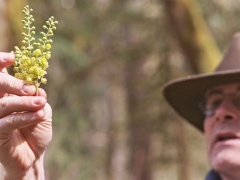
primary-image, l
Top | cafemama — an inconvenient life
(post, Sarah Gilbert)

primary-image, l
The pretty, dainty yellow violets, it turns out, are edible. As are the newly flowering red huckleberries, showy salmonberries, the sweet pink currants, and the blowsy bells of the Oregon grape. Here is what I learned in three hours in a quarter-mile walk into Forest Park: you CAN eat your flowers. And neither the Oregon grape, nor the sumac, are poisonous, despite what your mother may have told you. According to John Kallas of Wild Food Adventures: it's because of the mothers that these myths are perpetuated. "She's walking with her kids in the forest, and the kids are putting everything in their mouths, so she says, 'That's poisonous!' and they grow up and tell their kids," he says. We are eating the flowers. The first Oregon grape blossom (shown in photo) I taste is both beautiful and delicious, lemony and sharply sour, bright. I can imagine a jam made of the flowers. The yellow violets taste barely sweet, pleasant, and remind me of tender herb salads. Salmonberries are sour and unremarkable, although one of my classmates (a kindergarten teacher who I immediately like) loves them and continues to nibble as we walk. It is the red huckleberry flower that tastes most of what it will become, bright, very sour, full of huckleberry flavor. John Kallas has never thought or heard of making jam from Oregon grape flowers, though he loves the jam made of the fruits (it took three pieces of toast spread with the strongly-flavored stuff for him to develop a liking for it, he says) and he loves the idea. He likes most of these flowers tossed on your salad and says that nearly everything edible in the forest this time of year is right for salad. He describes how tender leafy plants suck up the water and sunlight between the budding branches, flourishing and bountiful, and then die away in the summer as blossoms turn to berry. And another thing: the parts you want to eat are the rapidly-growing ones, tender, full of life, not fibrous or woody yet. He shows how to cut large, new shoots of salmonberry leaves, peeling off the outer layer for an asparagus-like treat. This is the idea, too, behind the ladyfern fiddleheads (you know they're edible because they actually look like a perfect fiddle, curled concentrically): they're just shooting up, they're tender, delicious. We discover more things to eat along the trail, the flower clusters of the big leaf oak (they taste like watercress to me); fairy bells; sweet cicely; water leaf; wild ginger; licorice fern; solomon's seal. It seems plucked from a child's imagination, not forest, but fable. According to Kallas, in the city parks we must not pack out food but we can eat as much as we like while we're here. As runners carefully pound by on the muddy trails, I look at them and wonder, do you realize how much food you're missing? And we walk slowly, eating our flowers, thrilled with new knowledge. On the bike ride home, I see Oregon grapes lining both sides of the Eastbank Esplanade, and I think I'll take a few bunches of flowers home for the kids to taste. Near the opera building, I stop and pinch some off. They are bitter and astringent, nothing like the ones I remember in the forest. I couldn't decide if it was the mood of the walk, dreamy and full of possibility, or the realities of the dirt. Either way, I'll go to the forest again, to eat, to see the world populated with wild and fantastical tastes.